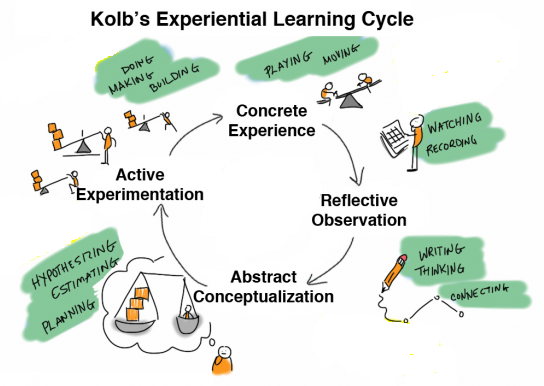- +254 (72)-041-0460
- gradschool@crystalperk.com
- Kaunda Ave, Kizingo, Mombasa, KE
In its simplest form, experiential learning means learning from experience or learning by doing. Experiential education first immerses learners in an experience and then encourages reflection about the experience to develop new skills, new attitudes, or new ways of thinking.
-Lewis & Williams (1994)
At CIRMI, “experiential education” is the term employed from the broader philosophical and institutional perspective, and “experiential learning” will be used when referring to learning-specific categories of the experience types or when discussing
Kolb’s (1984) model of experiential learning is one of the most widely used theoretical frameworks in education. The model is grounded in a constructivist and development perspective of learning. Experience itself plays a key role in learning, however it is only one phase in Kolb’s experiential learning cycle. Students can enter learning at an place but all stages in the cycle must be addressed for meaningful learning to occur.


“Western management has failed to understand cause and effect.”
W. Edwards Deming
…when you combine Deming & Goldratt, you get the robust Decalogue Methodology
The Decalogue is a science-based methodology that equips leaders and managers with the insight and foresight that comes from a systemic approach. It is founded on cause and effect logic that views an organization as a system, i.e. a set of components that work together to achieve the goal of the system. By understanding a company as a system and applying principles of systems theory, it enables whole system optimization.

The Decalogue integrates for the first time into a cohesive and rigorous whole the work of two systemic approaches to management: the work of W. Edwards Deming, the father of Quality, and the work of Dr. Eliyahu Goldratt known as the Theory of Constraints.
The Decalogue’s systemic approach to management demonstrates how choosing a strategic Constraint and managing Variation provides the foundations for sustainable growth for any company. The Ten Steps of the Decalogue equip business owners and leaders with a clear and focused path to achieve the maximum value with the resources available.
The steps combine the essence of Deming – a common goal and focus on processes and variation – with the essence of Goldratt’s message – focussing on the one factor that determines the pace of throughput and on overcoming the cognitive barriers to change. Continuous improvement and continuous innovation becomes part of the day-to-day.
The steps combine the essence of Deming – a common goal and focus on processes and variation – with the essence of Goldratt’s message – focusing on the one factor that determines the pace of throughput and on overcoming the cognitive barriers to change. Continuous improvement and continuous innovation becomes part of the day-to-day.
The Decalogue is an original contribution to the Theory of constraints and organizational science. Since 1999, it has been used by hundreds of companies to achieve fundamentally more with the resources available.
Discover how our literary works solve systemic challenges across all industries to achieve sustainable growth.
Proprietary data, expert analysis and bold thinking for leaders who want to achieve the extraordinary. A collection of our best thinking on strategy, management, organization and more.
Over the years we have communicated our approach to systemic management in a variety of ways. At the end of the 1990s, the unique blending of Deming and Goldratt into a methodology was first fully described by Domenico Lepore and Oded Cohen in ‘Deming and Goldratt: The Decalogue’. North River Press, 1999, translated into several languages and recommended reading in universities around the world.
“Western management has failed to understand cause and effect.”
W. Edwards Deming